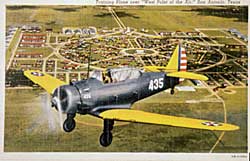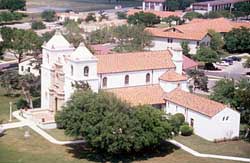
Randolph Field, Texas, played an exceptional role in the development of the air arm of the U.S. Army, which eventually achieved its independence as the U.S. Air Force in September 1947. It was conceived and designed as a model airfield for flight training in the mid-1920s for the fledgling Army Air Corps. The completed "Air City" became the site of unique Air Corps schools for flying training and aviation medicine, as well as a landmark in airfield planning and design. In addition, administrative headquarters at Randolph Field, including the Air Corps Training Center, the Gulf Coast Air Corps Training Center and the Army Air Forces Central Flying Training Command, were keystones in the organizational structure of the Army Air Corps and the Army Air Forces. Their roles were pivotal in the Army air arm's 40-year campaign to become an independent branch of the U.S. armed forces.

The Army began a flying training program soon after delivery of its first airplane to the Signal Corps in the summer of 1909. By the end of World War I there were 27 flying fields for training in the United States, however, all instruction at the schools ceased immediately with the signing of the Armistice (November 11, 1918). Rapid demobilization followed and flying training during the postwar period was erratic for several years. The Army eventually established a flying training system with two levels. Primary Flying Schools were located at Carlstrom Field in Arcadia, Florida, and March Field in Riverside, California. Three Advanced Schools were planned to provide training for pilots specializing in pursuit, bombardment, and observation. However, the Observation School at Post Field at Fort Sill, Oklahoma, was the only one to provide advanced training during this period because funds for training were so scarce. To conserve resources, the Army Air Service decided to centralize its flying training in 1922 at two fields about seven miles apart in San Antonio, Texas. Brooks Field provided primary flying training and the Advanced Flying School was located at Kelly Field. Passage of the Air Corps Act in July 1926 led to further reorganization of the flying training program, and the schools at Brooks and Kelly Fields became part of a new organization, the Air Corps Training Center.

Brig. Gen. Frank P. Lahm, one of the two assistants to the Chief of the Air Corps authorized by the Air Corps Act, became the Training Center's first commanding officer. Lahm was a pioneer in American aviation history, the first military officer taught to fly by Wilbur Wright in 1909 and the first American to win an international balloon competition (1906). On April 18, 1927, Lahm appointed a board of five officers to submit plans for a model field for flying training, including housing, administrative and school buildings, hangars, and associated support buildings and infrastructure. War Department General Order No. 12 (September 27, 1928) designated the planned flying field as Randolph Field, named in honor of Captain William M. Randolph, killed in an airplane accident at Gorman, Texas, on February 18, 1928. The dedication ceremony for Randolph Field was held on June 20, 1930, even though less than half of the construction was completed. The Air Corps Primary Flying School opened at Randolph Field on November 2, 1931. Flying training was no longer conducted at Brooks Field, but the Advanced Flying School remained at Kelly Field.

The Air Corps' need for an airfield specifically for flying training led to a radical new concept of airfield layout and design. It broke all previous precedents at Army posts and air stations. Over several years, the original idea for a field with a circular shape evolved into a model airfield for flying training that also incorporated the most advanced principles of the new profession of city planning. The final plan for Randolph Field produced a unique military installation that was an exceptional achievement for Army architects, planners, and Air Corps officers. Buildings and structures were generally constructed in the Spanish Colonial Revival style with hollow core tile and concrete block covered with stucco and roofs of Mission red clay tile. Hangars, however, were built in the Art Deco style and originally had checker-board painted roofs. Most of the buildings were built according to standardized plans designed by the Army Quartermaster Corps in the late 1920s. However, Randolph Field's most prominent buildings--the Administration Building, Chapel, School of Aviation Medicine and Cadet Academic Building--were designed by local architects. This was partly because the Quartermaster Corps did not have standardized plans for these special types of buildings, local architects were more familiar with local building conditions and materials, and the timetable for completing the Air Corps' new field. The entire installation was built in less than three years.

In the 1930s, Randolph Field was the location of the administrative Headquarters for the Air Corps Training Center, as well as the Air Corps Primary Flying School. The Air Corps Training Center was in charge of the entire Army pilot training program in the United States from 1931 to 1939. The Air Corps Training Center developed an efficient, well-coordinated flying training program that focused on the quality of its pilots.. The program was not only critical to the development of military flight training, but also to the training of American pilots, who after graduation spread out over the world, some to commercial airline jobs in Latin America and the Phillipines, others to government or industry occupations that took them to Europe and Asia. However, the program only produced about 200 pilots a year. Hitler's actions in Europe and America's belated recognition of the importance of air power led to a rising demand for rapid expansion of the Army Air Corps. The subsequent growth of the Air Corps prior to Pearl Harbor was phenomenal. Randolph Field's exceptional facilities allowed it to become the largest school for basic flight training in the United States until the Air Corps Training Center was broken up and flying training was expanded with new training centers in the southeast (Maxwell Field, Alabama) and on the west coast (Moffett Field, California).
Visit the National Park Service Travel American Aviation to learn more about Aviation related Historic Sites.
Last updated: August 29, 2017
